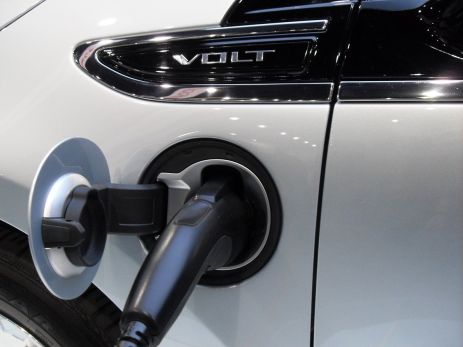 Charging up a Chevy Volt. Photo courtesy mkooiman via FlickrHere’s a conundrum as the electric-car future arrives: Once we all start hitting the highway in our Nissan Leafs, Chevy Volts and Think City’s, who’s going to pay for our roads?
Charging up a Chevy Volt. Photo courtesy mkooiman via FlickrHere’s a conundrum as the electric-car future arrives: Once we all start hitting the highway in our Nissan Leafs, Chevy Volts and Think City’s, who’s going to pay for our roads?
State and federal excise taxes on every gallon of gasoline sold in the United States currently finance a big chunk of road construction and pothole fixing, as Allan Schurr, an IBM executive, pointed out to me Tuesday when we sat down for some green car chat in San Francisco.
It’s one of the many consequences of constructing an electron-fueled alternative to the century-old transportation infrastructure that grew up around the internal combustion engine.
“I really believe that the complexity of electric mobility on the electric utility system is pretty unappreciated,” says Schurr, a vice president for energy & utilities at IBM.
Take the tax issue.
In car-crazy California, for instance, state fuel taxes provide about two-thirds of transportation funding, according to the Legislative Analyst’s Office. Nearly all that revenue is devoted to building and maintaining highways and local roads. (Which, of course, creates a vicious carbon circle as the more people drive the more taxes are collected for more roads to accommodate more cars.)
“People who build roads count on every single penny of those excise taxes and as soon as that fuel is switched they’re going to say, ‘Wait a minute, I’m all fine about changing fuels, but the roads still have potholes and I need my money,’ ” says Schurr.
“They are already seeing a flattening of road taxes and they’re falling behind,” he adds. “I don’t think they’re going to be very patient when Nissan is introducing 100,000 electric vehicles.”
So, just transfer the tax on gasoline and diesel to electricity, right? That’ll probably happen, Schurr says, but imposing a levy on electrons is easier said than done.
“Who’s going to collect the user tax?” he asks. “How do you know the electricity stream went into a car and not into a light bulb?”
Collecting gasoline taxes is a pretty straightforward proposition. A gallon of gasoline has physical dimensions and is only sold at specified locations — gas stations — where taxes are built into the pump price.
Now consider how owners of the Nissan Leaf — some 25,000 people who already put deposits down on the electric car — will charge up. They might plug in at home, at work, at the train station, or a friend’s house.
Who is responsible for collecting and paying the taxes? Is it the local utility? The charging station owner? My pal Chris?
Parsing that out is going to take not only smart charging technology that knows to charge me and not Chris, but some sophisticated software and billing systems, something utilities are not necessarily equipped to handle. At least, not just yet.
“Maybe the utilities won’t be part of it but that tax has to be collected,” Schurr says. “I’ve talked to utilities and said we fully expect there will be an excise tax put on electricity that will go toward transportation. Some utilities are expecting every charge post will be separately metered for that purpose.”
And that, of course, creates a potential economic bonanza for Big Blue and its competitors.
“Orchestrating all these business process changes for utilities is IBM’s opportunity,” says Schurr, who formerly ran California utility PG&E’s electric vehicle program back in the “Who Killed the Electric Car” era of the 1990s. “It’s doing it in an orderly way so the barriers to building public infrastructure or private infrastructure in your garage and operating it in smart charging mode are low.”
In other words, IBM will create a software platform to integrate services offered by electric car infrastructure companies like Better Place and Coulomb Technologies with the utilities grid management and billing operations — a vastly more complicated matter than plunking down a gas station on the corner of a well-traveled intersection.
The idea is to create software standards and processes that can be used by the U.S.’s 3,000 utilities.
Schurr believes that over time most electric car drivers will top off their batteries at public charging posts rather than by plugging in at a charging station installed in their garage. After all, unless you’re Mr. Burns or Donald Trump, you probably don’t have a gas pump in your garage.
“In California, people don’t have garages if they live in the cities,” says Schurr. “In the suburbs, it’s a two-car garage with one car in it and another car in the driveway.” Drivers, he notes, may be reluctant to spend $2,000 to install a charging station in their garage if they can plug in at the train station or other public charging spot.
Then there’s the economies-of-scale issue. Schurr argues it’s much cheaper to roll out a hundred identical public charging posts at a mall or office park than to install a hundred individual home charging stations in garages that will have to be separately inspected and possibly rewired depending on their voltage capacity.
And that charging infrastructure could not only create more sustainable cities but new economic opportunities for retailers, restaurants and other local businesses.
“I don’t think we can underestimate the amount of interest in public charging,” Schurr says. “Electric car owners are going to be a well-heeled demographic that you’ll want to attract. If you’re a restaurant, you want people to come and stay for a couple of hours so you might roll in two hours of free charging.”
In other words, some power with your power lunch.



